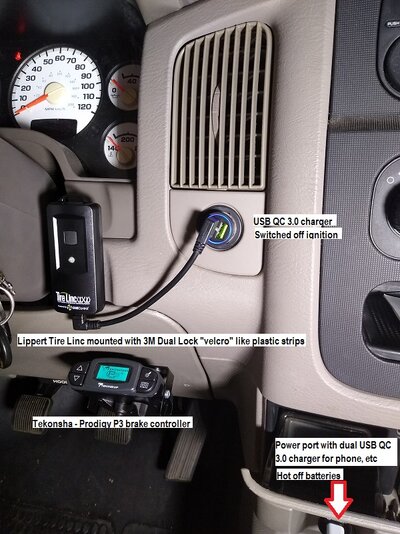Blaise
Well-known member
We are on a cross country trip from NY to CA, in KY at the moment. Before we left, I checked trailer tire pressures - all 4 tires were at about 65 PSI. The tag on the trailer says "cold pressure 80 PSI". So I pumped them up to 80 PSI each. Our GD Reflection has the "Compass Connect" feature - a phone app that connects to the trailer via blutooth. It allows you to control a bunch of stuff with your phone (lights on and off, slides in and out, leveling, etc). It also integrates the Tire Linc TPMS, which agreed with my pump that the tires were at 80 PSI. This was in NY with cold tires and an ambient temp of about 45 degrees F.
I knew temp and pressure would increase with driving, but I didn't know how much variance to expect. I set the pressure limits to 72 and 88 (+/- 8 PSI). We get on the road, and the TPMS squawks pretty quickly, complaining of PSI in the low 90's. Ambient temp was in the 80's. I let a bit of air out and increased the max limit to 95. TPMS warning went off again - pressures at 95 and tire temps in the 90's. It is quite a bit warmer here than it was in NY - ambient temp is low 80's. So the "cold" pressure of 80 here has got to be different than in NY. I mean, 80 PSI is 80 PSI. But if that is measured with an ambient temp of 45, the increase in pressure will be greater than if you set the tires at 80 PSI with an ambient temp of 75, no?
So what should I expect in terms of actual tire pressures and temps when "hot" (driving)? Trying to set reasonable tire pressure limits on the TPMS and stay safe.
The truck (a long bed dually) has a similar story, but less extreme: tires set to spec, front at 70 PSI and rear at 80 PSI (cold). Both are running about plus 10 PSI while driving.
Thanks for any guidance.
I knew temp and pressure would increase with driving, but I didn't know how much variance to expect. I set the pressure limits to 72 and 88 (+/- 8 PSI). We get on the road, and the TPMS squawks pretty quickly, complaining of PSI in the low 90's. Ambient temp was in the 80's. I let a bit of air out and increased the max limit to 95. TPMS warning went off again - pressures at 95 and tire temps in the 90's. It is quite a bit warmer here than it was in NY - ambient temp is low 80's. So the "cold" pressure of 80 here has got to be different than in NY. I mean, 80 PSI is 80 PSI. But if that is measured with an ambient temp of 45, the increase in pressure will be greater than if you set the tires at 80 PSI with an ambient temp of 75, no?
So what should I expect in terms of actual tire pressures and temps when "hot" (driving)? Trying to set reasonable tire pressure limits on the TPMS and stay safe.
The truck (a long bed dually) has a similar story, but less extreme: tires set to spec, front at 70 PSI and rear at 80 PSI (cold). Both are running about plus 10 PSI while driving.
Thanks for any guidance.
Last edited:

